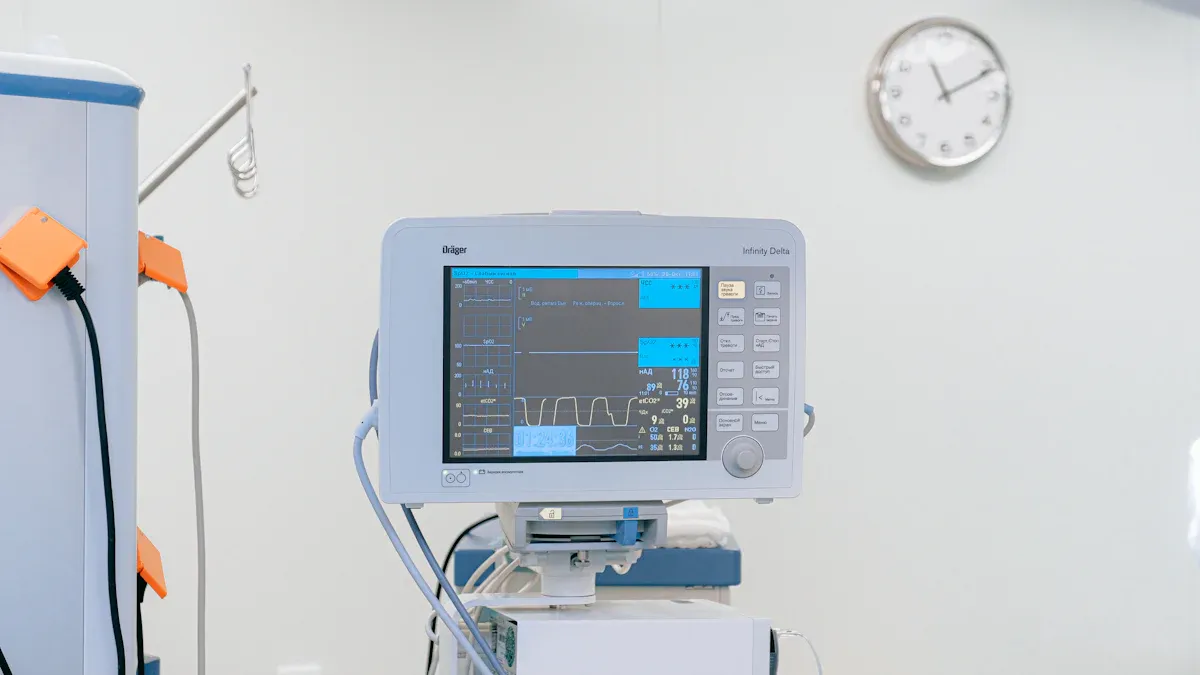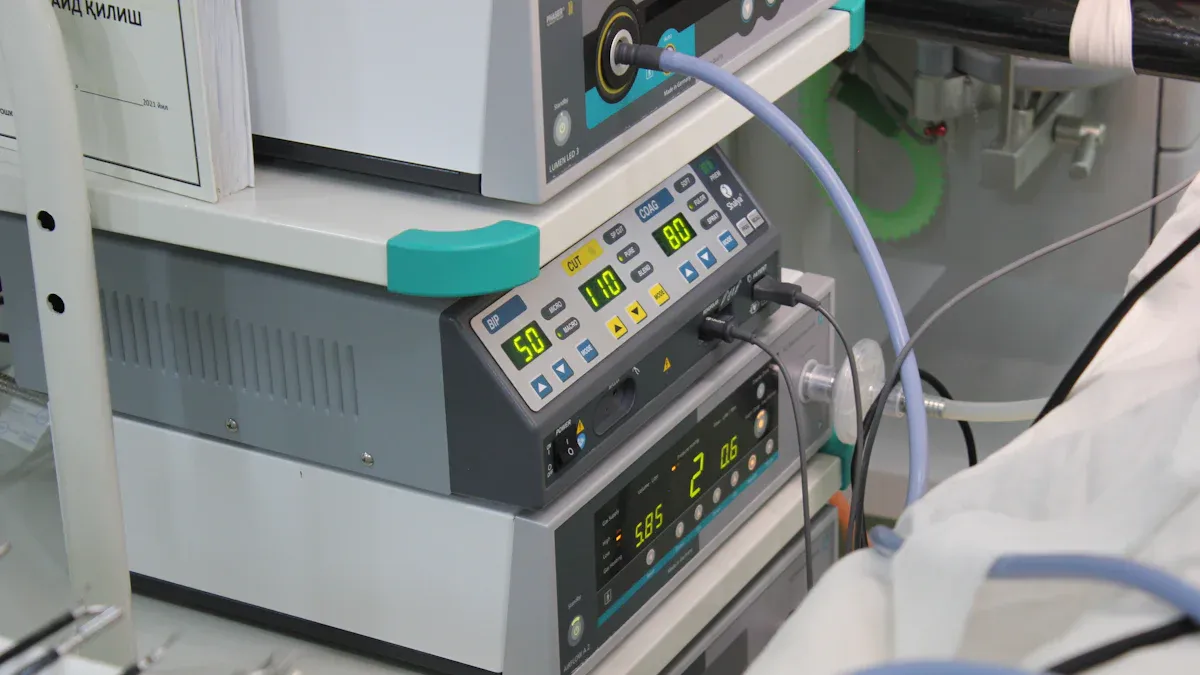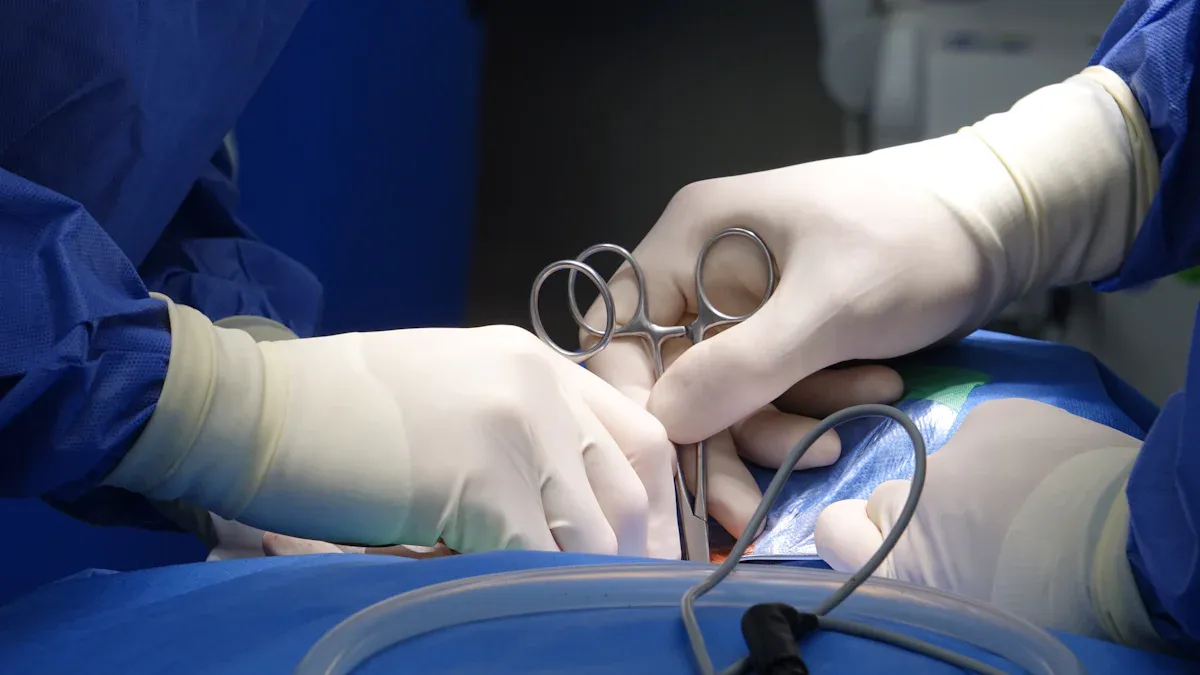Exploring the Superelasticity of Nitinol for Vascular Interventions

Navigating the intricate pathways of the human vascular system demands precision and adaptability. Nitinol's superelasticity plays a pivotal role in vascular interventions, enabling medical tools to bend and recover without compromising their structural integrity. This unique property allows nitinol guidewires to traverse complex vascular anatomy with unmatched efficiency. By resisting deformation and kinking, these guidewires ensure smoother procedures. The Nitinol Guidewire for Vascular Grafts further enhances surgical outcomes, providing the flexibility and control needed for delicate vascular repairs.
Key Takeaways
Nitinol can bend and return to shape without breaking. This helps guidewires move easily through tricky blood vessels.
Nitinol's memory lets devices go back to their original shape. This makes them more dependable during surgeries.
Nitinol guidewires lower the chance of hurting blood vessels. This keeps patients safer and reduces problems during treatments.
Nitinol is safe for the body and works well inside it. This makes it a top choice for long-term medical tools.
Using nitinol guidewires can help patients heal faster. It also improves results in blood vessel surgeries.
Overview of Nitinol's Material Properties
Composition and Structure of Nitinol
Nitinol, a nickel-titanium alloy, exhibits remarkable properties due to its unique composition and microstructure. It consists of approximately 55% nickel and 45% titanium, forming a crystalline structure that undergoes phase transformations. These transformations occur between cubic austenite and monoclinic martensite phases, enabling nitinol's shape memory and superelasticity. Researchers have observed an average grain size of 20 µm in nitinol, which significantly impacts its mechanical behavior. Variations in mechanical response have been noted depending on the rolling direction of nitinol sheets, highlighting the influence of crystallographic texture.
The correlation between microscopic and macroscopic behavior in nitinol has been established through advanced modeling techniques like finite element analysis (FEA). These studies emphasize the importance of microstructural geometry in optimizing nitinol's performance for medical applications.
Biocompatibility and Corrosion Resistance
Nitinol's biocompatibility makes it a preferred material for medical devices. Clinical studies have demonstrated its ability to integrate seamlessly with biological tissues. For example, in a canine aortic aneurysm model, nitinol stents showed no signs of corrosion and supported endothelial cell migration within one month of implantation. This alloy's passive nature and surface finish contribute to its exceptional corrosion resistance, ensuring durability in harsh environments.
Nitinol is widely used in cardiovascular devices, including stents and guidewires, due to its biostability.
Its applications have expanded into respiratory, neurological, spinal, and orthopedic fields, showcasing its versatility.
Unique Characteristics of Nickel-Titanium Alloys
Nickel-titanium alloys like nitinol stand out for their combination of shape memory and superelasticity. These properties allow nitinol to recover its original shape after deformation and absorb significant strain without permanent damage. This flexibility makes it ideal for medical devices such as catheters, stents, and orthodontic wires.
Key Characteristics | Description |
|---|---|
Shape Memory Effect | Returns to its original form upon heating, enabling self-expanding stents. |
Superelasticity | Recovers from large deformations without permanent damage. |
Biocompatibility | Well-tolerated by the human body, suitable for implants. |
Corrosion Resistance | Exceptional resistance to corrosion, ensuring long-term durability. |
Nitinol's lightweight nature and ability to undergo significant deformation further enhance its utility in medical applications. Its use extends to neurovascular interventions, colorectal surgery, and even as a replacement for sutures, proving its transformative impact on healthcare.
Superelasticity and Shape Memory in Nitinol

Defining Superelasticity in Medical Applications
Superelasticity is one of nitinol's most remarkable properties, making it indispensable in interventional radiology. This phenomenon occurs due to a phase transformation between the austenite and martensite phases of the alloy. Unlike conventional materials, nitinol can undergo large deformations and return to its original shape without permanent damage. This behavior is particularly useful in medical applications, where devices must adapt to the body's dynamic and complex anatomy.
Nitinol's superelasticity is characterized by:
A diffusionless phase transformation between austenite and martensite phases.
Large recoverable strains, allowing devices to bend and flex without breaking.
Tensile testing data that reveal its elasticity, superelasticity, and plasticity as distinct deformation modes.
Stress-strain curves derived from experimental studies provide critical insights into nitinol's performance. These curves help calibrate simulation models, ensuring the reliability of medical devices used in interventional radiology. This property enables nitinol guidewires to navigate tortuous vascular pathways with precision and resilience.
Shape Memory and Its Role in Nitinol Guidewires
The shape memory effect is another defining feature of nitinol. This property allows the material to "remember" its original shape and return to it when exposed to specific conditions, such as heat. In interventional radiology, this capability is vital for devices like guidewires, which must adapt to the vascular system's unique challenges.
Nitinol guidewires leverage the shape memory effect to maintain their structural integrity during procedures. For example, when a guidewire deforms while navigating a vessel, it can recover its original shape upon removal or heating. This ensures consistent performance and reduces the risk of device failure. The shape memory effect also enables self-expanding stents, which deploy automatically when exposed to body temperature, simplifying procedures and improving outcomes.
The combination of superelasticity and shape memory makes nitinol an ideal material for interventional radiology. These properties allow medical devices to perform reliably under the mechanical stresses of vascular interventions, enhancing both precision and patient safety.
Temperature-Dependent Behavior of Nitinol
Nitinol's behavior is highly dependent on temperature, which influences its phase transformations and mechanical properties. At higher temperatures, the alloy exists in the austenite phase, exhibiting elastic and almost linear behavior. When cooled, it transitions to the martensite phase, where it can undergo detwinning and elastic deformation.
Temperature (°C) | Phase | Behavior Description |
|---|---|---|
81 | Austenite | Exhibited elastic, almost linear behavior, returning to original length upon release. |
18 | Martensite | Underwent detwinning and elastic deformation, resulting in a residual elongation of approximately 7.1mm. |
This temperature-dependent behavior is crucial in interventional radiology. Devices like nitinol guidewires rely on these phase changes to adapt to the body's varying conditions. For instance, the guidewire's flexibility and strength can be optimized by controlling its temperature during manufacturing and use. This adaptability ensures smooth navigation through complex vascular structures, reducing the risk of complications.
The ability to fine-tune nitinol's properties through temperature control underscores its versatility in medical applications. This makes it a preferred choice for interventional radiology, where precision and adaptability are paramount.
Structural Advantages of Nitinol Guidewires

Flexibility and Durability in Vascular Pathways
Nitinol guidewires excel in flexibility and durability, making them indispensable for navigating vascular pathways. Their superelasticity allows them to bend and flex without permanent deformation, ensuring smooth passage through intricate anatomical structures. This flexibility is complemented by exceptional fatigue resistance, enabling nitinol to endure millions of stress cycles without failure. Fatigue testing has demonstrated that nitinol can withstand up to 10⁷ cycles under strain amplitudes ranging from 0.5% to 2.9%, highlighting its reliability in demanding medical procedures.
The durability of nitinol guidewires also ensures consistent performance during repeated use. This reliability reduces the need for frequent replacements, making them a cost-effective choice for healthcare providers. Additionally, their biocompatibility ensures safe interaction with the body, further enhancing their suitability for medical applications.
Resistance to Kinking and Deformation
One of the most significant advantages of nitinol guidewires is their resistance to kinking and deformation. This property is critical for maintaining the structural integrity of the guidewire during complex procedures. Mechanical testing has validated this resistance, as shown in the table below:
Measurement Type | Helical Coil (Platinum-Nickel) | Shaft Portion (Stainless Steel) | p-value |
|---|---|---|---|
Kink Angle (K α) | 68.3° | 55° | 0.00032 |
Remnant Angle (R α) | 15° | 23.9° | 0.00046 |
Deformation | Smaller due to higher flexibility | Larger due to lower flexibility | N/A |
The superior kink resistance of nitinol guidewires ensures that they retain their shape and functionality even under extreme conditions. This characteristic enhances control and precision during procedures, reducing the risk of complications.
Smooth Navigation Through Tortuous Anatomy
Nitinol guidewires are designed to navigate tortuous anatomy with ease. Their unique flexibility and shape memory properties allow them to adapt to the body's complex structures. After deformation, the guidewire returns to its original shape, ensuring consistent performance throughout the procedure. This adaptability is crucial for accessing hard-to-reach areas, particularly in minimally invasive surgeries.
Clinical outcomes have shown that nitinol guidewires improve patient safety and comfort by reducing complications during procedures. Their enhanced maneuverability allows healthcare professionals to achieve precise placement and movement within the body. These advancements have revolutionized medical device technology, setting new standards for innovation and improving outcomes for patients undergoing complex interventions.
Practical Benefits of Nitinol Guidewire for Vascular Grafts
Enhanced Precision and Control During Procedures
Nitinol guidewires offer unmatched precision and control during vascular interventions. Their superelasticity and shape memory properties allow surgeons to navigate intricate pathways with ease. These guidewires adapt to the body's dynamic anatomy, ensuring accurate placement of medical devices while minimizing trauma to surrounding tissues.
Studies have documented key metrics that highlight the precision and control provided by nitinol guidewires:
Metric | Description |
|---|---|
Fatigue Life | Measures strain amplitudes and fracture probabilities over 10⁷ cycles. |
Tensile Strength | Assesses the maximum load the tubing can handle before failure. |
Residual Elongation | Evaluates the difference in tensile strain between loading and unloading curves. |
Manufacturing techniques significantly influence these metrics. For example, tube processing methods directly impact the fatigue life of nitinol components, ensuring their reliability during demanding procedures. High-purity materials further reduce the risk of fractures, enhancing the guidewire's performance under stress.
Nitinol guidewires excel in flexibility, durability, and biocompatibility, making them indispensable for precise control during complex surgeries.
Reduced Risk of Vessel Damage
The unique properties of nitinol guidewires minimize the risk of vessel damage during vascular interventions. Their exceptional flexibility and kink resistance allow smooth navigation through tortuous anatomy, reducing the likelihood of mechanical trauma. Unlike traditional materials, nitinol absorbs strain without permanent deformation, ensuring safe interaction with delicate vascular structures.
Clinical studies have shown that nitinol guidewires maintain their structural integrity even under extreme conditions. This reliability ensures consistent performance, reducing complications such as vessel perforation or device failure. Accurate placement of stents and grafts becomes achievable, further safeguarding patient health.
Key benefits of nitinol guidewires include:
Safe navigation through complex anatomical structures.
Reduced trauma to surrounding tissues.
Enhanced durability during repeated use.
These advantages make nitinol guidewires a preferred choice for vascular graft procedures, where precision and safety are paramount.
Improved Patient Outcomes and Recovery Times
The use of nitinol guidewires in vascular grafts has transformed patient outcomes. Their ability to navigate complex anatomy with precision reduces procedural complications, leading to faster recovery times. Patients experience less post-operative discomfort due to the minimized risk of vessel damage.
Nitinol guidewires also contribute to the success of minimally invasive surgeries. Their flexibility and biocompatibility enable surgeons to perform delicate interventions with greater confidence. As a result, patients benefit from shorter hospital stays and quicker returns to daily activities.
Key Findings | Description |
|---|---|
Impact of Manufacturing Techniques | Different techniques significantly affect the mechanical properties of nitinol tubing, crucial for medical applications. |
Fatigue Life Correlation | The study indicates a strong correlation between tube processing methods and the fatigue life of nitinol components. |
The transformative impact of nitinol guidewires extends beyond individual procedures. Their reliability and adaptability set new standards for medical device technology, improving the overall quality of care in vascular interventions.
By enhancing precision, reducing vessel damage, and improving recovery times, nitinol guidewires have revolutionized vascular graft procedures, ensuring better outcomes for patients worldwide.
Comparison with Other Materials
Stainless Steel Guidewires: Strengths and Limitations
Stainless steel has long been a staple material for guidewires in medical applications. Its primary strength lies in its high tensile strength, which provides excellent pushability and torque control. These properties make stainless steel guidewires effective for navigating relatively straight vascular pathways. Additionally, stainless steel is cost-effective and widely available, making it a practical choice for many healthcare providers.
However, stainless steel guidewires have notable limitations. Their rigidity can make them prone to kinking when navigating tortuous anatomy. This lack of flexibility increases the risk of vessel damage during complex procedures. Furthermore, stainless steel lacks the superelasticity of nitinol, which limits its ability to recover from deformation. These drawbacks reduce its effectiveness in advanced vascular interventions.
Polymer-Coated Guidewires: Pros and Cons
Polymer-coated guidewires offer enhanced lubricity, which facilitates smoother navigation through vascular pathways. The polymer coating reduces friction, allowing the guidewire to glide more easily through tight or tortuous vessels. This feature makes them particularly useful in procedures requiring high precision.
Despite these advantages, polymer-coated guidewires have their own set of challenges. The coating can wear off over time, potentially leading to debris in the bloodstream. This issue raises concerns about long-term safety and durability. Additionally, polymer-coated guidewires often lack the mechanical strength and flexibility of nitinol, making them less suitable for demanding procedures.
Note: While polymer coatings improve maneuverability, they do not address the structural limitations of the underlying material.
Why Nitinol Stands Out in Medical Applications
Nitinol combines the best qualities of flexibility, durability, and biocompatibility, making it superior to both stainless steel and polymer-coated guidewires. Its superelasticity allows it to bend and recover without permanent deformation, ensuring consistent performance in complex vascular pathways. Unlike stainless steel, nitinol resists kinking and adapts to the body's anatomy.
Additionally, nitinol's shape memory effect enhances its functionality. Devices made from nitinol can return to their original shape after deformation, providing unmatched reliability. Its corrosion resistance and biocompatibility further solidify its position as the material of choice for advanced medical applications.
Material | Key Strengths | Key Limitations |
|---|---|---|
Stainless Steel | High tensile strength, affordable | Prone to kinking, lacks flexibility |
Polymer-Coated | Enhanced lubricity | Coating wear, limited durability |
Nitinol | Superelasticity, shape memory | Higher cost |
Nitinol's unique properties make it indispensable for modern vascular interventions, setting a new standard for medical device performance.
Nitinol guidewires revolutionize vascular interventions with their unique structural properties. Their superelasticity ensures smooth navigation through complex vascular pathways without permanent deformation. The shape memory effect allows stents to expand at body temperature, optimizing their fit and support within blood vessels.
Nitinol's biocompatibility minimizes adverse tissue reactions, reducing complications like restenosis.
These advancements set new standards for precision and safety in medical procedures. By combining flexibility, durability, and adaptability, nitinol transforms modern healthcare, improving patient outcomes and recovery times.
FAQ
What makes nitinol guidewires unique compared to other materials?
Nitinol guidewires stand out due to their superelasticity and shape memory. These properties allow them to bend and recover without permanent deformation. Unlike stainless steel or polymer-coated wires, nitinol resists kinking and adapts to complex vascular pathways, ensuring precision and safety during procedures.
How does nitinol's temperature-dependent behavior benefit medical applications?
Nitinol's phase transformations, influenced by temperature, enhance its adaptability. At body temperature, it transitions to the austenite phase, enabling devices like self-expanding stents to deploy effectively. This behavior ensures optimal performance in dynamic environments, improving procedural outcomes.
Are nitinol guidewires safe for long-term use in the body?
Yes, nitinol guidewires are biocompatible and corrosion-resistant. Clinical studies confirm their ability to integrate with biological tissues without adverse reactions. Their durability and resistance to wear make them suitable for long-term medical applications, including implants and vascular interventions.
Why is superelasticity important in vascular interventions?
Superelasticity allows nitinol guidewires to endure large deformations and return to their original shape. This flexibility ensures smooth navigation through tortuous anatomy, reducing the risk of vessel damage. It also enhances the precision and control required for complex vascular procedures.
How do nitinol guidewires improve patient outcomes?
Nitinol guidewires minimize complications by reducing vessel trauma and ensuring accurate device placement. Their flexibility and biocompatibility enable minimally invasive procedures, leading to shorter recovery times and improved patient comfort. These benefits contribute to better overall healthcare outcomes.
Tip: Nitinol's unique properties make it a game-changer in modern medicine, offering unmatched reliability and adaptability for vascular interventions.
See Also
Understanding Nitinol's Unique Properties: Shape Memory and Elasticity
Nitinol Tubing: Innovative Uses in Modern Healthcare Solutions
How Nitinol Tubing Contributes to Progress in Medical Tech
Nitinol Tubing: Transforming the Future of Medical Equipment
The Importance of Nitinol Tubing in Modern Medical Practices

